Cockroaches
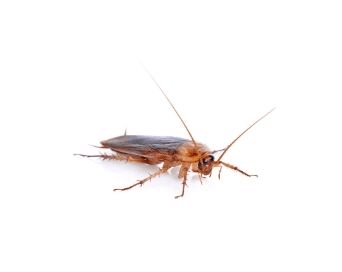
About Cockroaches
Cockroaches can measure over 50 mm (2 in) length, with tropical species tending to be larger than those found in other climates. Cockroaches have six legs, two antennae and some have wings. However, most winged cockroaches are not particularly adept at flying.
Let’s be honest here. Roaches are nasty little creatures. They crawl all over your stuff and hide in all those areas that are hard to reach. It’s not just that roaches are creepy with those long antennae and six legs. They can cause a variety of health issues. Research has shown that roaches worsen the condition of childhood asthma and can spread bacteria all over your premises. Roaches can become a serious infestation if left unchecked and once they get on your premise, they can be difficult to get rid of.
American cockroaches are 1.5 inches long, making them the largest of the house-infesting cockroaches. American cockroaches generally live in moist areas, but they can survive in dry areas if they have access to water. American cockroaches prefer warm temperatures. In residential areas, these cockroaches live in basements, around pipes and sewers, and may move outdoors into yards during warm weather. These cockroaches can be found in basements, crawl spaces, and foundations.
People often blame a cockroach problem on poor housekeeping. While cleaning floors, kitchens, and bathrooms are useful and very important to reduce food sources used by cockroaches, they may get inside and cause an infestation for other reasons. These pests can hitch a ride on infested items brought inside, get indoors via cracks and gaps in the home’s exterior, enter through drains or sewer pipes and a few species of cockroaches can fly inside when attracted to lights.
The German cockroach is the number 1 cockroach of concern, it is the species that gives all other cockroaches a bad name. They are unable to survive in locations without humans or human activity.
They’re among nature’s most vile, disgusting critters, and they can be nearly impossible to kick out of your house. Cockroaches live all over the world, but their favorite residence is your house, where they can snack on your food, damage books, and spread germs to you and your family.
Cockroaches are generally medium-sized insects, although in some parts of the world they can get quite large. They have spiny legs and long antennae. If you see even one roach, you’ve undoubtedly got a lot more. The problem is they generally hide during the day, so you may need to look for them at night with a Flashlight Even if you can’t find any of the insects, check cupboards and pantries for their droppings — tiny brown slime stains or pellets. Cockroaches breed incredibly quickly. Take action to get rid of them immediately, or you could find yourself with a major infestation on your hands.
Where do they live?
A cockroach is a resourceful pest able to survive almost anywhere that food, water, and shelter are available. Because humans have similar needs, it’s no fluke that the pests thrive in houses.
Inside
Trash or lawn clippings that collect too close to homes may lure the insects indoors. Because they prefer to be close to food and water, these pests can often and quickly move into kitchens and bathrooms preferring to hide in:
- Cabinets under sinks
- Inside or under garbage cans
- Near food prep areas
- Porous surfaces like wood and cardboard
Outside
Outside, cockroaches are commonly found under decks and places where plumbing and sewer leaks are found as well as in or around:
- Brush
- Crawl spaces
- Dumpsters & Garbage cans
- Fallen logs
- Leaf litter
- Mulch
- Storage sheds
Types of Cockroaches
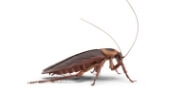
American Cockroach
Facts, Identification & Control
Length: Adults can be slightly more than 50 mm (3 inches) long.
Color: Adult American cockroaches are reddish-brown or mahogany colored. The area behind their heads is outlined with a yellow band.
Reproduction
Female American cockroaches make protective cases for their eggs. These cases are capsule-shaped. After forming a capsule, the roach deposits it in a warm, humid area. An average American roach egg capsule contains about 16 eggs.
When the eggs hatch, the tiny nymphs come out of the capsule. As they grow, the baby cockroaches shed their skins. If there is plenty of food, American cockroaches can develop from egg to adult in as little as 5½ months.
Behavior & Diet
Both male and female American cockroaches can fly. The wings develop when the roaches become adults.
American cockroaches normally live outdoors. They prefer warm, damp areas like flowerbeds, and under mulch. In many parts of the United States, people call them “palmetto bugs” because they live on trees. American cockroaches are very common in the sewer systems of many American cities.
American cockroaches enter homes to find water or food. They can easily pass under doors if the weather stripping is damaged. Basement windows and garages are also common entryways. When American cockroaches enter homes, they often go to bathrooms, kitchens, laundry rooms, and basements.
Outdoors, American cockroaches eat leaves, tiny wood particles, fungi, and algae. They also eat small insects. Indoors, American cockroaches forage under appliances, in drains, in kitchen cabinets, and on the floor. They eat crumbs, scraps of food, and spilled food that they find. They will also eat pet food that is left out overnight.
Signs of American Cockroach Infestation
Sightings
Homeowners may see these active cockroaches. American roaches can run very fast, and they usually scurry into a dark area. If they are startled, American roaches may even fly.
Droppings
American cockroaches leave their droppings in the dark areas where they hide. Homeowners may find these droppings in basements, in pantries, or behind appliances.
American cockroach droppings are small, and sometimes people mistake them for mouse droppings. American cockroach droppings have ridges on the sides and they are blunt on the ends. Mouse droppings have pointed ends. Since mice groom themselves, mouse droppings often have hairs embedded in them.
Egg Capsules
American cockroach egg cases are about 38 mm long. They are dark-colored—reddish or blackish brown. Homeowners often find these egg cases in basements, in laundry rooms, or kitchens. The egg cases may be under cabinets or behind appliances. American cockroaches also deposit their egg capsules behind stored items in garages and sheds.
Odor
Cockroaches produce a chemical called an “aggregation pheromone.” The odor of this chemical causes the roaches to stay together in groups. Some people describe the odor of these pheromones as having a “musty” smell. As the roach population starts to grow, people with sensitive noses may begin to notice this odor.
How Did I Get American Cockroaches?
American cockroaches enter the home to find water or food. They can easily pass under doors if the weather stripping is damaged. Basement windows and garages are also common entryways. When American cockroaches enter homes, they often go to bathrooms, kitchens, laundry rooms, and basements.
How Serious are American Cockroaches?
Cockroaches are filthy pests. They can spread disease, contaminate our food, and cause allergies and even asthma. Cockroaches can pick up germs on their legs and bodies as they crawl through decaying matter or sewage and then transfer these germs to food or onto food surfaces. According to the World Health Organization (WHO), they are proven or suspected carriers of the organisms causing diarrhea, dysentery, cholera, leprosy, plague, typhoid fever, and viral diseases such as poliomyelitis.
We encourage people to help reduce cockroach populations by removing all food and unnecessary water sources, sealing all cracks and crevices, vacuuming, and removing shelter sites like cardboard and paper. To effectively manage a serious cockroach infestation, you must correctly identify the type of cockroach causing the infestation, which is why it is important to contact a pest control professional.
How Do I Get Rid of American Cockroaches?
Our Specialists are trained to help manage American cockroaches. Since every home is different, our technician will design a unique program for your situation.
Keeping American cockroaches out of your home is an ongoing process, not a one-time treatment. Our solution is a continuing cycle of three critical steps—Assess, Implement, and Monitor.
Assess the situation
Our technician will do a thorough inspection of your home—inside and outside. There are several things the technician will do during the inspection:
- Locate areas of American cockroach activity.
- Identify the causes of the American cockroach problem.
- Look for entryways that American cockroaches could be used to get into your home.
- Implement a customized solution
The technician will customize the treatment to the situation. He can select from a variety of tools and techniques to help keep American cockroaches out of your home:
Exclusion–Nonchemical methods such as caulking or door sweeps help keep American cockroaches from entering your home.
Landscape modification—If American roaches are living around your home, it may be necessary to remove dead leaves or rake mulch away from the foundation. The technician will point out these opportunities.
Gel or granular bait—These are applied in areas where American cockroaches will eat them but children or pets cannot reach them.
Insect growth regulator—Applied into cockroach hiding places, these interfere with the cockroaches’ normal development.
Residual insecticides—Applied into cracks and crevices, these help keep American cockroaches from hiding in the treated areas. The technician may also apply liquid insecticide outdoors to help keep American cockroaches from coming inside.
Monitor
Every time the technician returns to your home, he or she will make an inspection. There are several things he will do during the inspection:
- Confirm that the previous treatment was effective.
- Check for new American cockroach activity.
- Identify changes to the home or landscape that could make your home vulnerable to the American cockroach invasion.
- Our technician can provide the right solution to keep American cockroaches in their place … out of your home. For more information or to schedule an inspection, please Contact Us or Book Service Now
Convenient, Lasting, and Affordable Treatment
Convenience
Our Specialist can work around your schedule. In many cases, treatments will be made on the outside—sometimes with no need for you to be at home.
On-Going Process
Keeping American cockroaches out of your home is an on-going collaborative process, not a one-time event. Our solution is the ideal way to help keep these pests where they belong—outside your home.
Pricing
While it might seem easy to quote a service price online, in fact, it really is almost impossible. Since every home is unique, no two treatment plans should be exactly the same. The best way to prescribe an effective treatment plan and to quote an accurate price is by having a trained professional complete a comprehensive inspection.
More Information
The American cockroach is also commonly known as the water bug, flying water bug, or palmetto bug. These large cockroaches can grow to exceed 50 cm in length. Although the American cockroach is a major pest in the United States, they are native to the tropical climates of Africa. Some evidence has suggested that the American cockroach was brought to North America aboard ships.
They are a peridomestic species and live primarily outdoors. In southern states, they are common in shady, humid areas like flowerbeds and around trees. In northern areas, they are usually found in sewers and drains. Climate changes or food shortages can cause them to move indoors.
When they move indoors, American cockroaches prefer to live in moist, humid environments. They can also survive in dry areas with sufficient food and water sources. These insects favor temperatures between 70 and 80 degrees Fahrenheit. When an American cockroach population infests a human home, the insects are drawn to food storage and preparation areas, as well as moist locations. In industrial settings such as restaurants and bakeries, they can be found in boiler rooms and steam tunnels. In residential and commercial buildings, the American cockroach typically infests basements and landscaping.
American cockroaches are moderate flyers. They also gather together in open spaces, while other domestic cockroaches tend to hide in cracks and crevices. They do enjoy sweet foods but prefer decaying material.
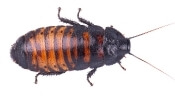
Madagascar Hissing Cockroach
Facts, Identification & Control
- Size: Growing up to 7.5 cm in length, they are one of the largest cockroach species
- Color: Madagascar hissing cockroaches are brown in color.
- Characteristics: Both nymphs and adults are wingless with horns and long antennae. Males have larger pronotal humps on their thorax and bushier antennae than females.
How Did I Get Madagascar Hissing Cockroaches?
Homeowners who find a Madagascar hissing cockroach have likely discovered someone’s missing pet. In the U.S., these insects live in classrooms as display insects and pet stores that offer these critters for sale. Padded feet allow these cockroaches to climb anywhere, so it is possible for them to crawl out of containment that is properly sealed and made inescapable.
How Serious Are Madagascar Hissing Cockroaches?
These insects pose no known danger to humans. Males are extremely aggressive and are commonly seen fighting with rival males.
How Do I Get Rid of Madagascar Hissing Cockroaches?
Our technician is trained to help manage Madagascar hissing cockroaches and similar pests. Since every building or home is different, our technician will design a unique program for your situation.
We can provide the right solution to keep cockroaches in their place and out of your home or business.
Behavior, Diet, & Habits
These cockroaches are also commonly referred to as hissing cockroaches. Some people refer to them as giant cockroaches. Despite their large size, Madagascar hissing cockroaches are capable of hiding within incredibly narrow spaces.
What Do They Eat?
In their natural environment, they are helpful as consumers of carrion and decay. Hissing cockroaches are omnivores which feed primarily on:
- Animal carcasses
- Fallen fruit
- Rotting plants
- Small insects
Where Do They Live?
These large pests thrive in warm climates and become sluggish as temperatures cool. Madagascar hissing cockroaches live in moist areas including:
- Beneath rotten logs
- Forest floors
- Tropical areas
Geographical Range
These roaches are native to Madagascar. Because they aren’t native to the country, these pests are rarely the cause of cockroach infestation in the house.
Life Cycle
Young Madagascar hissing cockroaches stay in close contact with females for an extended period of time after birth. Nymphs undergo six molts in a span of approximately seven months before reaching the adult stage and can live up to five years.
Hissing
The Madagascar hissing cockroach is the only known insect species capable of hissing. While other insects create sound by rubbing body parts together, these cockroaches hiss by releasing air from their abdominal spiracles. These roaches produce two kinds of hisses: upon reaching a certain developmental stage, all hissing cockroaches can produce the disturbance hiss, but only males ever emit the fighting hiss.
Male cockroaches establish and defend territories using a unique sound. They are very territorial and use their horns in combat. Females only hiss when disturbed. The hiss plays an important role in:
- Colony hierarchy
- Communication
- Courtship
Why Do They Hiss?
Male Madagascar hissing cockroaches hiss to communicate with other cockroaches to:
- Attract mates
- Scare off enemies
- Warn others
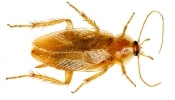
Brown Banded Cockroach
Facts, Identification & Control
- Size: one of the smallest of the invasive cockroaches, the adult brown-banded cockroach may reach 11 to 14.5 mm in length.
- Color: These colorful roaches received their name from the light brown or tan transverse bands that are present on the wings of the adult and across the body of the young, or nymphs.
How Did I Get Brown-Banded Cockroaches?
These cockroaches need warm temperatures to survive. As a result, they often enter homes looking for shelter, but the most common way that brown-banded cockroaches get inside a home is when infested furniture, food products, grocery items, and electronics are brought into the house. Living areas with access to food and ample hiding places are favorite spots for brown-banded cockroaches.
How Serious Are Brown-Banded Cockroaches?
Brown-banded cockroaches will feed on almost anything from trash and pantry goods to nylon stockings, drapes, and wallpaper. Brown-banded cockroach infestations can pose a number of health risks. These roaches have been found to carry and spread harmful bacteria and protozoa which cause gastroenteritis and diarrhea. More commonly, roaches indoors have been found to trigger asthma and allergies. Also, these roaches are able to transfer disease organisms that cause food poisoning and dysentery by contaminating food, cooking utensils, and food preparation surfaces.
How do I Get Rid of Them?
The first step in addressing any cockroach infestation is to identify the species correctly. The techniques used to manage one species seldom prove effective when applied to another species. Thus, it is best to contact us if you suspect an infestation.
Our Specialists are trained to help manage roaches. Since every home is different, the technician will design a unique program for your situation.
Keeping these roaches out of your home is an ongoing process, not a one-time treatment. Our solution is a continuing cycle of three critical steps—Assess, Implement, and Monitor.
We can provide the right solution to keep brown-banded cockroaches in their place…out of your home.
Facts
Where do they live?
Brown-banded cockroaches prefer dry and warm locations and can be found inside cabinets, pantries, and closets. They can also be found in electronic equipment or around refrigerator motor housings. Brown-banded cockroaches can also hide from humans in a variety of places such as clocks and picture frames. They tend to avoid water sources and are more commonly found near the ceilings of infested homes.
Nocturnal
Active primarily at night, the brown-banded cockroach may be seen wandering in search of food during the day.
What do they eat?
Brown-banded cockroaches, like other cockroach species, are opportunistic feeders. However, when provided a choice, they have a preference for materials with higher starch content, such as book bindings, wallpaper glue, and stamps.
Life Cycle
An adult brown-banded cockroach can live anywhere from 130 to 315 days, with an average life span of 206 days. During that time, a female brown-banded cockroach will produce approximately 14 egg capsules or oothecae, during the course of her life. She produces the ootheca, which contains an average of 10 to 18 eggs, carries it for approximately 24 to 36 hours, and then attaches it to the protected underside of a surface until the young hatch. Once the young hatch, the time needed to develop varies greatly depending upon the environmental conditions, ranging from as few as 90 days in ideal conditions or as many as 276 in more harsh environments.
Signs of a Brown-Banded Cockroach Infestation
Primarily Nocturnal
Brown-banded cockroaches are usually nocturnal, or active primarily at night. However, it is not uncommon to spot these insects actively looking for food in the daytime, or scurrying away from the light when a cabinet door or drawer is opened.
Droppings
Brown-banded cockroach infestations can often be identified by the droppings they leave behind. Often found in those areas where the insects frequent, these droppings appear as dark brown or black specks or smears. These fecal spots are used by the brown-banded cockroach to communicate a safe gathering point for other cockroaches in the area. For brown-banded roaches, these may be visible along with the crown molding of ceilings, around ceiling light fixtures and even behind pictures mounted high on a wall, to name a few.
Egg Capsules
The small, almost 5 mm, egg case may go unnoticed attached to the underside of protected surfaces or within cracks. However, once these cases become dislodged, especially after hatching, the tan egg cases may become visible.
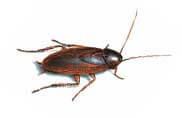
smoky-brown cockroach
Facts, Identification & Control
- Length: Adults can reach 38 mm long.
- Wings: These strong fliers have wings that extend beyond their body.
- Color: Adults have a shiny appearance and are uniformly a black, mahogany color. The later nymphs are similar in color as adults, but the early nymphal stages have a whitish colored stripe on their thorax and on the tips of their antennae. These roaches are often found in leaf litter and mulch, so their coloration helps to hide or camouflage them against predators.
How Did I Get Smokybrown Cockroaches?
Common Attractors
These cockroaches usually are found in basements and ground floor levels. Some common attractors are:
- Leaky roofs and standing water
- Stacks of wood
- Exposed trash
- Sewer openings
How Do They Get Inside?
The pests crawl inside through small holes in siding or home foundations and also will fly through open doors and windows.
How Serious Are Smokybrown Cockroaches?
These insects become a pest when attracted by interior lights, they gain entry into a home or structure through openings in windows, doors, and other gaps into the home.
The pests contaminate the surfaces they touch, spreading bacteria that can result in serious illness. Proteins in smoky brown cockroach skin and saliva may also trigger asthma or allergic reactions. The pests are capable fliers and their appearance often frightens people who are not used to seeing large, flying cockroaches.
Signs of a Smokybrown Cockroach Infestation
Sightings
These insects are commonly found outdoors and can be seen primarily at night, walking in search of food. Common sighting locations include:
- Landscaping beds
- Ivy or other ground covers
- In and around gutters and fascia of homes and structures
Droppings
Fecal material and droppings can be evident in areas that the smoky brown cockroach frequents.
Egg Capsules
Attached to a surface within a day of production, the 11 to 14 mm long, dark-brown to black egg case, or ootheca, may be observed in areas that the smoky brown cockroach frequents.
How Do I Get Rid of Smokybrown Cockroaches?
Our technician is trained to help manage smoky brown cockroaches and similar. Since every building or home is different, our technician will design a unique program for your situation.
We can provide the right solution to keep smoky brown roaches in their place…out of your home, or business.
Behavior, Diet & Habits
Geographic Range
The smoky brown cockroach is a common pest of the southeastern United States. Although mainly found from central Texas eastward to Florida (They are major pests in cities such as Houston and New Orleans), and as far north as North Carolina, the smoky brown cockroach also has been found as far north as Indiana and Illinois. They have also been found in Southern California.
Where Do They Live?
These large cockroaches live in areas that are warm, with high humidity, and in wooded areas where they are often found in tree holes and under mulch. Outdoors, smoky brown cockroaches can be found in areas that are warm, very moist, and protected from the elements. Since this insect is prone to dehydration, the availability of a moist environment is critical for its survival.
They are nocturnal and hide in small places during the day, making themselves inaccessible to humans and predators. They prefer non-dwelling areas such as greenhouses, nurseries, and gardens. Around homes and structures the smoky brown cockroach can be found:
- In tree holes and cavities
- Beneath mulch beds and ground cover
- Around soffits, eaves, and gutters, or areas where moisture problems may exist
- In gutters
Inside, they breed in attics, where their populations can grow unnoticed.
What Do They Eat?
Smoky brown cockroach feeding activity is most evident during the late dusk or early dawn hours when the insects leave their hiding places in search of food. It is also not uncommon to see these insects taking a drink when water is available.
While smoky brown cockroaches prefer to eat decaying plant matter, the opportunistic feeders will consume any food source available to them, such as:
- Dead insects
- Fecal matter
- Meats
- Starches
- Sweets
Reproduction
Lifespan
Depending on environmental conditions, the development time for a smoky brown cockroach, from egg to adult, can vary greatly, with a range of 160 days to 716 days. As adults, a female lives an average of 218 days, and a male will live, on average, 215 days.
The lifespan of smoky brown cockroaches averages over a year, although they can live as long as 2 years or more under ideal conditions.
Eggs
Females can produce an average of 10 egg cases, or ootheca, with an average of 20 eggs per case. Each female can produce up to 32 oothecae in one lifetime. These egg cases are then attached to a protected surface within a day of production, where they will remain until the young hatch.
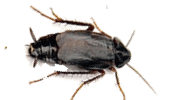
Oriental Cockroach
Facts, Identification & Control
The adults of the oriental cockroach are very different in appearance.
Male
- Size: 25 mm long max
- Wings: three-quarter-length wings, leaving the last few abdominal segments exposed
- Color: Shiny black to a dark reddish-brown color
Female
- Size: 32 mm long max
- Wings: None, only large wing pads that cover the first couple of segments of the body
- Color: Shiny black to a dark reddish-brown color
How Did I Get Oriental Cockroaches?
These cockroaches prefer homes with plenty of damp, dark, and sheltered areas to breed and develop. Oriental cockroaches often travel through sewers and may come inside through pipes and drains. Abundant outdoor plants may also provide places for these cockroach populations to flourish and get inside houses in search of food. Also, leaking pipes and other plumbing leaks are very attractive to Oriental cockroaches.
How Serious Are Oriental Cockroaches?
Oriental cockroaches will eat almost anything, including decaying organic matter and trash. They often live in rarely used sink drains, garbage disposals, under cabinets that contain plumbing, or in bathroom voids. As they forage for food in homes, the pests may transfer disease-causing bacteria to pantry goods and countertops.
Diseases
Oriental cockroaches can be a source for many food-borne pathogens, including E.coli, Salmonella spp., and other pathogens. Due to their dietary preference for garbage and decaying organic matter, oriental cockroaches can carry these pathogens on their legs and bodies from contaminated areas and then transmit them onto clean surfaces.
In addition, oriental cockroaches secrete odors from their bodies. These odors are very noticeable if the population is large and can taint food by changing its smell or flavor.
How Do You Get Rid of Cockroaches?
Our specialists are trained to help manage cockroaches. Since every home is different, the technician will design a unique program for your situation.
Keeping roaches out of your home or building is an ongoing process, not a one-time treatment. Our solution is a continuing cycle of three critical steps—Assess, Implement, and Monitor.
We can provide the right solution to keep roaches in their place…out of your home or business.
Signs of an Oriental Cockroach Infestation
Sightings
During the warmer months, it is not uncommon to find oriental roaches outside around landscaping beds, congregating beneath moist gutters, or even scurrying out from storm drains and sewer grates at night. Mostly active at night, they can be found during the day in areas and rooms that are kept primarily moist, dark, and undisturbed.
Egg Capsules
Egg cases, or ootheca, of the oriental cockroach, may appear dark brown or reddish in color and almost 8 to 10 mm in length. Each egg case, which can hold approximately 16 eggs, is dropped by the female into protected areas, almost 30 hours after it is produced.
Odor
In areas where large populations of oriental cockroaches are present, a musty odor can be detected. This odor is a result of chemicals that are secreted by the insects that are used to communicate within the population.
Behavior, Diet & Habits
How do they get into the home?
Oriental cockroaches are a pest invader that most frequently gains entry beneath the thresholds of doors, through open doors or gaps beneath siding, even following utility lines, pipes, open drains, or sewers into a structure or home.
Where do they live?
Primarily an outdoor species, oriental cockroaches are well adapted for surviving in the natural environment. Most outdoor populations can be found living beneath the mulch in landscape beds, in leaf litter, beneath stones or debris outdoors. If access is available, the insects can thrive in the voids or openings beneath porches, in wall voids, and crawlspaces. In more metropolitan areas, oriental roaches can be found in large numbers living in storm drains and sewers. Oriental roaches prefer cool, damp locations, so they can also be found in basements and cellars. Oriental cockroaches crawl around service ducts, toilets, bathtubs, sinks, radiators, and pipes.
Gathered Near Water
Although their natural habitat is outdoors, they may infest homes in summer. Inside, they tend to remain on lower floors. Like other cockroach species, Oriental cockroaches are omnivorous and thrive by scavenging for food crumbs and decaying plants and animals. Oriental cockroaches tend to gather in large numbers near water sources.
What Do Oriental Cockroaches Eat?
Oriental cockroaches are known for their preference of feeding on garbage, filth, or material that has begun to decay. These cockroaches are very dependent upon water. While studies have shown that they can survive for up to a month without food, these insects can not survive for more than two weeks without water.
Can they fly?
Neither the male nor female is capable of flight.
Distribution
Oriental cockroaches thrive in port cities throughout the world. They can be found throughout the United States, as well as in England, Europe, Israel, Australia, and South America.
Reproduction & Life Cycle
On average an adult male oriental cockroach will live 110 to 160 days, whereas the adult female can live anywhere from 35 to 180 days. During that time, a single female oriental roach can produce approximately eight egg cases, or ootheca, with approximately 16 eggs per case. Approximately 30 hours after she has produced the egg case, she will drop it in a protected area where it will stay until the young hatch.
The development time for the oriental cockroach is greatly affected by the season. In the warmer months, the time needed to develop from an egg to an adult may take as few as 200 days. However, when the weather becomes colder, or during the late fall and winter months, it can take as many as 800 days for the cockroaches to go from egg to adult.
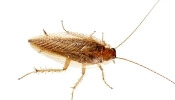
German Cockroach
Facts, Identification & Control
- Color: Adults are easily recognized by their light brown or tan coloration with two black horizontal stripes located on the pronotum immediately behind the head, The young, or nymphs, are darker, almost black in color, also with the black stripes behind the head.
- Size: Adults grow to a length of 13-16 mm.
- Wings: While adult German cockroaches have wings, they rarely fly, preferring to run.
How Did I Get German Cockroaches?
German cockroaches are a well-known indoor cockroach with a distribution that is world-wide. Smaller than other types of cockroaches, the pests can hide in small spaces and hitch rides in bags, boxes, and many other infested items that are brought inside the home. In multi-unit apartment buildings, they can easily move between units, using the shared plumbing and pipes as a highway.
What Attracts Them?
One of the most common sources of problems with German cockroaches is used items like furniture and luggage. Pre-owned electronics are also hiding places for pests, which gravitate towards these warm devices. Additionally, areas, where food debris is left around, will fulfill the needs that the cockroaches have for food, water, and protection, such as near:
- Garbage containers
- Kitchen cabinets
- Under sinks
How Serious Are German Cockroaches?
German cockroaches spread filth in homes, contaminating food and utensils. Pathogens range from bacteria that cause food poisoning and dysentery to allergens that result in rashes and asthma attacks. Recent studies have also indicated that in larger metropolitan areas, the development of asthma in children can be directly linked to the presence of the pest.
Rapid Infestation
These cockroaches lay 40 eggs at a time, which mature in about two months. Because they reproduce rapidly, infestations quickly become severe. German cockroaches are hardy and fast and have few natural predators inside human habitats. For these reasons, their populations tend to grow rapidly and can be hard to get rid of, often requiring professional treatment.
Signs of Infestation
Droppings
German cockroach droping may appear as small, dark, “pepper-like” material left on countertops or in drawers. Fecal staining may appear as dark spots or smears:
- Along the tops of doors.
- Around small cracks and openings into walls.
- In the corners of a room.
Egg Capsules
Since German cockroach females carry their egg case until 1 to 2 days before depositing it, empty egg cases may be found in areas that the females frequent.
Odor
German cockroaches are also known to secrete a number of odorous compounds. When populations are present in large numbers, it may be possible to detect a mild, or what some have reported as a “musty” odor.
How Do I Get Rid of German Cockroaches
Our technician is trained to help manage German cockroaches and similar pests. Since every building or home is different, our technician will design a unique program for your situation.
We can provide the right solution to keep German cockroaches in their place…out of your house
Behavior, Diet & Habits
Where Do They Live?
Although capable of living outdoors in tropical environments, German cockroaches are most commonly found indoors, with a preference for the warmer and more humid areas of a structure. In homes, these cockroaches will typically be found in kitchens and bathrooms but can move to other areas of a home if food and moisture are available.
What Do They Eat?
German cockroaches are scavengers, capable of feeding on most any food source available. The pests will eat:
- Bindings of books
- Crumbs missed during cleaning or on dirty dishes.
- Soap
- Toothpaste
Life Cycle
Each egg case, or ootheca, contains approximately 30 to 40 eggs. This egg case is then carried by the female until 1 to 2 days before hatching. Depending upon the conditions, the average time for development, from egg to adult can range from 54 to 215 days, with an average of approximately 100 days.
Reproduction
German cockroaches are known for their ability to reproduce quickly. Females only need to mate once for the production of young. After mating, and under normal conditions, they will produce, on average, 4 to 6 egg cases during the course of their lives.
Lifespan
As adults, German cockroaches can survive anywhere from 100 to 200 days.
German Cockroaches vs. Asian Cockroaches
Asian cockroaches, a pest of the southeastern United States, are often mistaken for the German cockroach. Similar in appearance, the main differences between the two cockroaches are evident in their behavior.
While German cockroaches are known as a pest of structures, found frequently in areas of high humidity and temperature, Asian cockroaches are most frequently found outdoors, and only occasionally make their way into structures. In addition, Asian cockroaches are known for their ability to fly, whereas German cockroaches rarely use their wings for flight and prefer to run from danger.
Let's Work Together!
Get rid of those Pests!




